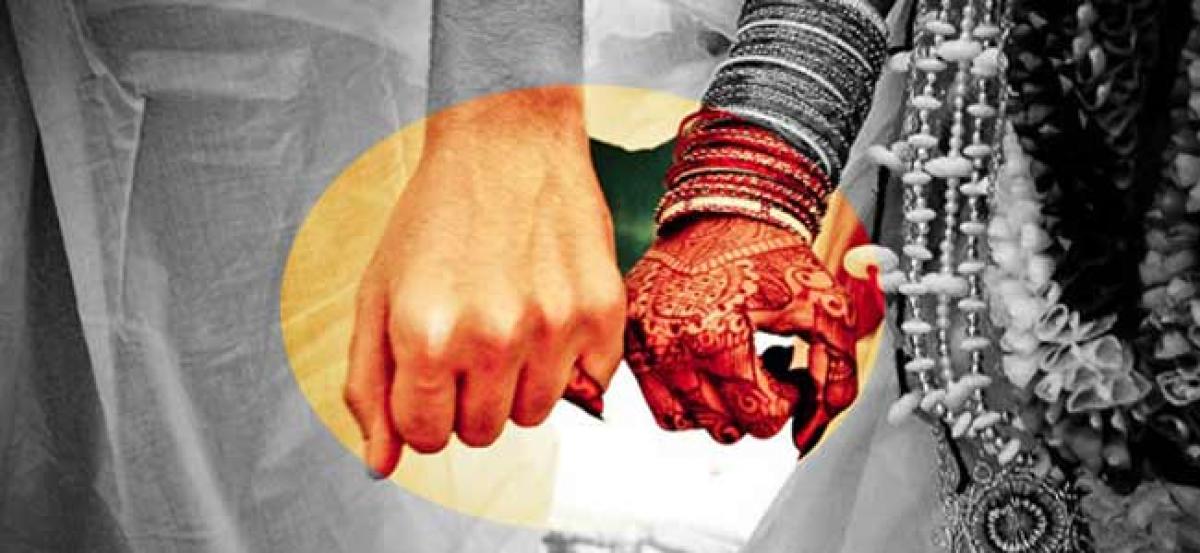Live
- DEO suspends teacher accused of sexual assault
- PM ‘cursing’ Congress out of despair: Maharashtra Cong Chief
- Applications are invited for Junior Colleges Scheme District Scheduled Castes Development Officer Ramlal
- A nomination was filed on the second day for the Nagar Kurnool parliamentary seat
- SP Gaikwad inspected the Telangana Amarnath Saleswaram Jatara yatra arrangements
- Rahul Gandhi's decision to contest from Wayanad shows 'lack of confidence': BJP President Nadda
- IPL 2024: Delhi bowlers will go after all of SRH’s top-order batters, says head coach Ricky Ponting
- At Amroha rally, PM Modi sends out ‘meaningful’ message for Muslims and Hindus
- Tripura records highest 79.83 pc voter turnout in Northeast
- The government has to clear the confusion
Just In

Marriage is a sacred sanctity that no one tends to question. It is an all harmonious bond that is made out of love, faith and companionship.
New Delhi : Marriage is a sacred sanctity that no one tends to question. It is an all harmonious bond that is made out of love, faith and companionship.
Yet the modern age marriage isn't as sanctuous as one imagines it to be.
Even Indian marriages, the most sacred of all religions, are no stranger to such hassles.
According to Solene Paillet, Head of Communication Management of Gleeden, it is wise to remember the rituals one has to undertake at the very point of marriage and understand their importance.
- Family traditions. India is known for its abundance in diversity and although there are universal components in the Hindu ceremony, each region in India comes with its set of local customs and each family may pray to different gods and goddesses. Ask your family about specific regional traditions. This instils the fact that the marriage needs to be blessed by higher powers in order to succeed and thrive.
- Creating a sacred space. The need to create a sacred space has been cherished through the rites of Hindu customaries. One way to honour that tradition is to have the ceremony under a four pillar canopy, and raised platform, called a mandap, which represents a temple. This sanctity of the temple emulates the act of taking auspicious blessings through pooja. While traditionally the couple sits on thrones or pillows, interfaith couples usually stand at the altar.
- Lighting the sacred fire. A key aspect of the Hindu ceremony is to light a scared fire, usually created from ghee and wooden wicks, to evoke the God, Agni (Fire), to bear witness to the ceremony. I often ask a dad, brother, or uncle to create the sacred fire. One family wanted to use coconut oil and so the bride's father tended the fire through the whole ceremony. This spirit of Agni in invoked to cleanse the union of all the evil eyes and words and build it on purity and transparency.
- Garland Exchange. During the ceremony the couple exchanges fresh garlands, welcoming each other into each other's families. I like to make it one of the first gestures in an interfaith ceremony. It is a lovely way to establish a connection between the couple and their loved ones. It is an invitation to join souls and involvement into each other's life for the longer run.
- The Seven Sacred Steps. The highlight is Saptapadi, also called "The Seven Steps." Traditionally, the bride's sari is tied to the groom's Kurta, or a sari shawl might be draped from his shoulder to her sari. He leads, often by her pinkie linked with his pinky, in seven steps around the fire, as the priest chants seven blessings or vows for a strong marriage. By walking around the fire they are agreeing to these vows. With each step, they throw small bits of puffed rice into the fire, representing prosperity in their new life together. This is considered the most important part of the ceremony, as it seals the bond between the couple forever.
Paillet further stated, the following are a few mantras that the couples have to repeat while taking the seven sacred steps:
1. May this couple be blessed with an abundance of resources and comforts, and be helpful to one another in all ways.
2. May this couple be strong and complement one another.
3. May this couple be blessed with prosperity and riches on all levels.
4. May this couple be eternally happy.
5. May this couple be blessed with a happy family life.
6. May this couple live in perfect harmony... true to their personal values and their joint promises.
7. May this couple always be the best of friend.
These mantras will come of great importance as one travels through the strife and tribulations of a regular marital union.

© 2024 Hyderabad Media House Limited/The Hans India. All rights reserved. Powered by hocalwire.com







